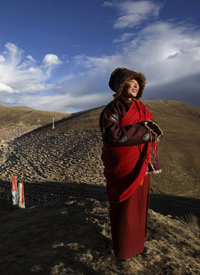“Altitude affects your thinking, your breathing and your ability to sleep. But high-altitude natives in Tibet don't have these problems. They live a healthy life, and they do it completely comfortably.”
Mountaintop Survival is in the Genes
Professor Cynthia Beall's research on Tibetans can make breathing easier the world over
 Tibetans live and work 2-to-3 miles above sea level. This extreme altitude could be harmful or even deadly for most people, but a researcher at Case Western Reserve University says Tibetans have been genetically programmed to thrive under such harsh conditions.
Tibetans live and work 2-to-3 miles above sea level. This extreme altitude could be harmful or even deadly for most people, but a researcher at Case Western Reserve University says Tibetans have been genetically programmed to thrive under such harsh conditions.
"Altitude affects your thinking, your breathing and your ability to sleep. But high-altitude natives in Tibet don't have these problems," says Cynthia Beall, PhD, an anthropologist and a Case Western Reserve distinguished university professor. "They live a healthy life, and they do it completely comfortably."
One key to their success is a special variant of a gene called EPAS1, which Beall and her colleagues described in Proceedings of the National Academy of Sciences this summer. Among other duties, EPAS1 helps control hemoglobin concentration in the blood. While all humans have the gene, Tibetans' version allows them to maintain a healthy amount of hemoglobin in conditions that can prove perilous for others.
People traveling at high altitude tend to make extra hemoglobin—the oxygen-carrying component of blood—which allows them to take in more air with every breath. Too much hemoglobin, however, can cause chronic mountain sickness—an overreaction to altitude that causes the blood to become thick and syrupy. The condition is common among Andean highlanders, but Tibetans' version of EPAS1 has evolved to allow generations of natives better cope in thin air.
"Tibetans have lived at high elevation for more than 10,000 years," Beall explains. "Over time, the individuals who inherited the EPAS1 variant survived and passed it on to their children until eventually it became the most common form of the gene in the population as a whole."
Better understanding Tibetans' evolution has implications that reach far beyond the mountaintops of Asia.
Even at sea level, many people—especially those with lung disease or heart problems—are affected by low levels of oxygen in their blood. Beall hopes that by understanding how populations like the Tibetans have adapted to cope in oxygen-poor circumstances, researchers will be able to develop treatments for people around the world.
The research could also help predict who is at greatest risk for altitude sickness—potentially deterring would-be thrill-seekers from scaling heights their bodies haven't evolved to manage.
See more of the picture: Read more at Think.

